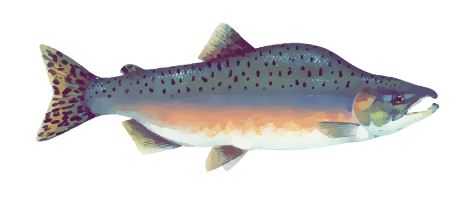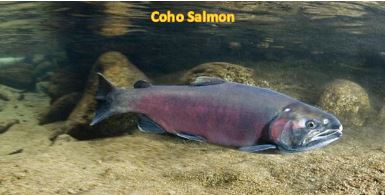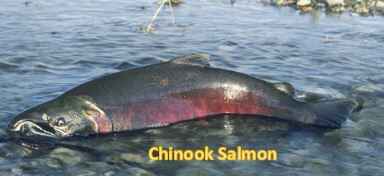SALMON FISH | SALMON FISH FARMING | ATLANTIC SALMON Vs PACIFIC SALMON | SALMON FISHING IN IDAHO, WISCONSIN, NEW YORK, WASHINGTON, OREGON, MAINE – 2024
BASIC INFORMATION ABOUT SALMON FISH
Salmon is the very common name for this species of fish that belongs to a ray-finned family named Salmonidae. There are other fishes in the same family which include trout, char, grayling, and Whitefish. Salmon are native to tributaries of the North Atlantic and belong to the genus Salmo and the Pacific Ocean (genus Oncorhynchus). Many species of salmon have been introduced into non-native environments such as the Great Lakes of North America and Patagonia in South America. Salmon belongs to Kingdom:-Animalia, Phylum:Chordata, Class:-Actinopterygii, Order:- Salmoniformes, Family:-Salmonidae, Subfamily : Salmoninae.

Typically, salmon fishes are migrating ones that keep on migrating from place to place, generally, they hatch in freshwater migrate to the ocean, then return to the freshwater, migrate to the ocean then again return to the freshwater to reproduce. However, populations of many species are restricted to freshwater throughout their lives. It has been a mythology that the fish returns to the same spot where they hatched to spawn.
The tracking studies have shown that it’s almost true. A portion of returning salmon run May stray and spawn in the different freshwater systems; the percentage of straying depends on the species of the salmon. The salmon is a type of fish that is slender and graceful its Latin name means “the leaper”. Its distinctive characteristics make it easier to recognize in all the species of fish that it’s a salmon. It has a small head, blunt nose, small eyes, and a mouth that gapes back below its eyes. The mouth contains a row of stout and conical teeth. As these are the basic characteristics of salmon fish.
SALMON FISH FARMING
Talking about the geographical areas of farming salmon fish, In 2008 two-thirds of the world’s supply of farm-raised salmon was produced in Norway and Chile, by the Food and Agriculture Organization of the United Nations. One-half of the world’s farming salmon were produced by four international companies, with 26 other companies producing the remaining half.
Salmon farming is restricted to areas where suitable ocean temperatures and protected bays are present. If we keenly observe the stages of salmon fish farming is a three-stage process. In which the first step includes the hatching of the eggs in freshwater tanks. If observed the young salmon are raised in the tanks or in channels of running water for approximately 12 to 18 months. And at least then they are transferred to cages along the seashore where they are grown to maturity.
Several operations are being ruined such as a typical cage used for raising salmon which consists of metal or plastic frames with mesh netting covering the sides and bottom. The top is seen frequently opened and rarely or something it is covered. The shape may be round or square which is 30 to 90 feet wide and about 30 feet deep. Many cages may be connected In a protected bay with each other holding up to 90,000 salmon. These fishes naturally feed upon smaller baitfish. In captivity, they are fed pellets containing fish, fish oils, nutrients, and colour enhancers. They also eat baitfish that wander into cages.
A very important thing is if a virus or disease breaks out in salmon farming, antibiotics, and other medicines can be added to the food. The very important thing is harvesting in farming. In the case of salmon fish farming, salmon producers stop feeding the salmon about a week before harvesting. The benefit of this thing is it gives the fish time to rid themselves of any waste left in their digestive system. The salmon are then rounded up with nets and placed into water rich in carbon dioxide.
This process then anesthetizes them before their gill arches are cut out, allowing much of the blood to drain out. They are quickly placed into an ice water slurry, which stops any spreading of enzymes and retains the fish’s color and flavor. From the ice slurry, they are gutted and processed.
BEST SALMON FISHING IN IDAHO
Salmon fishing in Idaho is very famous. The state encourages saltwater and freshwater fishing. In Idaho, Chinook Salmon is the most popular species of Salmon for fishing. Fishing is observed in the Columbia River and its tributaries and also near the connecting area of the river and ocean. Chinook Salmon is also popular by the name King Salmon. This species is the largest of all Salmon.
The later part of spring is the best season for Salmon Fishing. This fishing requires necessary licenses and permits. also, we have to check the requirements.
SALMON FISHING IN WISCONSIN
Salmon fishing in Wisconsin is a popular and exciting activity for anglers. Various types of Salmon are observed in Wisconsin including Coho Salmon, and Chinook Salmon which are expensive. If someone asks for the best place to fish, that will be Green Bay, Lake Michigan, and the Door Country Peninsula.
The fishing charters and guides available provide help including gear, bait, and the best place/spot for fishing. A sturdy fishing rod, reel, and line are necessary, along with the popular fishing lures and baits. One important thing that should not be missed is a fishing license which can be obtained from the Wisconsin Department of Natural Resources. The best time for salmon fishing in Wisconsin is from late summer to early fall.
SALMON FISHING IN WASHINGTON
Salmon fishing in Washington is a popular and rewarding activity for anglers. It is home to several species of Salmon. Species found in Washington include Chinook Salmon, Coho salmon, Sockeye Salmon, and Pink Salmon.
Freshwater and saltwater fishing is enjoyed in Washington. Saltwater Salmon fishing in Washington is typically done in Puget Sound and the straight of Juan de Fuca. These areas offer excellent opportunities for Chinook and Coho Salmon. Charter boats and guided fishing trips are available for those who want to explore this water and target Salmon.
Freshwater Salmon Fishing in Washington also exists in several regions including the Columbia River, the Shake river, and the Klickitat River.
A fishing License for all anglers, and can be obtained from the Washington Department of Fish and Wildlife.
SALMON FISHING IN NEW YORK
New York is a great place for Salmon fishing. Salmon fishing in New York can be an enjoyable and challenging experience for anglers of all skill levels.
New York is home to several species of Salmon including Chinook Salmon, Coho Salmon, and Atlantic Salmon which are highly sought after by fishermen. Hence Salmon fishing in New York is famous.
The best time for Salmon fishing in New York depends upon the type of species you are targetting. Chinook and Coho Salmon are found in Lake Ontario tributaries in late spring and early summer. while Atlantic Salmon are typically caught in the fall.
The most popular places for Salmon fishing in New York include Lake Ontario and the Finger Lakes. We can find many fishing charters and guide services available.
SALMON FISHING IN OREGON
Oregon is a hometown for a variety of Salmon fishes like Chinook, Salmon, Coho Salmon, Sockeye Salmon, and Pink Salmon.
As usual, Anglers should have a valid fishing license. Fishing of Salmon is regulated by the Oregon Department of Fish and Wildlife.
The best season to catch Chinook Salmon and Coho Salmon is in the summer and fall.
PRESENCE OF MERCURY IN SALMON FISH
As we can see nowadays there are various types of pollution present in the environment and if we are fish consumers in high amounts then water pollution in high amounts nowadays is very hazardous to our health as the fish present in the water contains heavy metals which we can see available in salmon fish.
The contamination of the tissues present in the fish with organic and organic containments has been a pervasive environmental and public health problem. The current study reports that the concentrations of the nine metals in tissues of farmed Atlantic salmon which is salmo salar and two species of wild-caught salmon (chum[Oncorhynchus keta] and coho [O.kisutch] analyzed as part of a global survey of containments in these fish.
Among the nine metals, organic arsenic was significantly higher in farmed than in wild salmon, whereas cobalt, copper, and cadmium were significantly higher in farmed than in wild salmon. None of the containments exceeded federal standards or guidance levels.
According to the study of the researchers, the amount of mercury present in fish and other seafood depends from species to species or the lives of pollution in its environment. In accordance with the study, the duration from 1998 to 2005 found that 27%of fish from 291 streams around the United States contained more than the recommended limit.
Types of species of salmon
There are several types of Salmon fish available in the Atlantic and Pacific regions. Let’s see one by one,
Atlantic Salmon
Atlantic Salmon is found in the North Atlantic region. These Atlantic salmon are commonly farmed in the North Atlantic Region. They are rich in test and hence preferred in restaurants.
Pacific Salmon
Pacific Salmon refers to a group of Salmon species that are found in the Pacific Ocean.
Pink Salmon (Oncorhynchus gorbuscha)
Pink Salmon is found on the Pacific coast of North America. The size of Pink Salmon is quite small concerning other types of Salmon.

Sockeye Salmon or Red Salmon (Oncorhynchus nerka)
Sockeye Salmon is found in the Pacific and Arctic oceans. It is also called Red Salmon due to its color. It is expensive due to its test.
Coho Salmon or Silver Salmon (Oncorhynchus kisutch)
Coho Salmon are found on the Pacific coast of North America. This species is also called Silver Salmon.

Chinook Salmon or Pacific King Salmon (Oncorhynchus tshawytscha)
Chinook Salmon are found on the Pacific coast of North America. Chinook Salmon is also famous by the name King Salmon. This species is the largest of all the Salmon.

Atlantic Salmon Vs Pacific Salmon
Atlantic Salmon and Pacific Salmon are two types of Salmon fishes, based on their availability in a specific region. Atlantic Salmon are widely available and are more expensive than Pacific Salmon.
a. Origin – Atlantic Salmon are found in the Atlantic Ocean whereas Pacific Salmon are found in the Pacific Ocean.
b. Size – Atlantic Salmon are large ( approx 60 pounds) in comparison with Pacific Salmon (between 5 to 15 pounds).
c. Taste – Atlantic Salmon is often described as having a milder, more buttery flavor than Pacific Salmon, which has a slightly stronger, more flavorful taste.
Some important and Useful Articles
Pomfret Fish | Types of Pomfret fish| Golden Pomfret
Pomfret is one of the most popular species of fish like Salmon and Catla fish and is very commonly seen. The species of fish is the perciform Fish which belongs to the family of Bramidae. This family currently includes 20 species across seven genres. more…
Tuna Fish | Types of Tuna Fish | Farming and presence of mercury in Tuna Fish in 2024
A tuna is a fish that mostly lives in saltwater. It belongs to the tribe of Thunnini which is a subgrouping of the Scombridge family. Most of the tunas are found in shouls in the tropical and temperate seas. These fish belong to the kingdom Animalia, phylum Chordata. more…
FAQs
Is Pacific salmon safe to eat?
Pacific Salmon are safer with low mercury content in comparison with Tuna Fish and Catla Fish.
What are the 5 types of salmon in Alaska?
Chinook salmon, sockeye salmon, chum salmon, pink salmon, and coho salmon are commonly observed in Alaska
Is Pacific salmon dog food?
Dogs can eat Salmon fish. Pacific salmon contains proteins and omega-3 fatty acids, which are good nutrients.

One thought on “SALMON FISH | SALMON FISH FARMING | ATLANTIC SALMON Vs PACIFIC SALMON | SALMON FISHING IN IDAHO, WISCONSIN, NEW YORK, WASHINGTON, OREGON, MAINE – 2024”